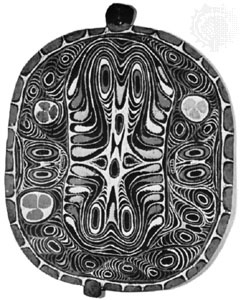curvilinear style
art
 in visual arts, two-dimensional surface ornamentation that dominates the art of the Gulf of Papua region in southeastern Papua New Guinea. The style is characterized by a curving line used to form abstract patterns, such as spirals, circles, swirls, and S-shapes, as well as to define human facial features. The straight line and the right angle are practically nonexistent in both the abstract and the anthropomorphic types of ornamentation. In representations of human faces—which display the typical features of the Neolithic Melanid tradition, the oldest cultural strain in Oceania—the forehead, nose region, and perimeter of the face are described by an unbroken, curving line that outlines the nose, swings up over the eyes, and descends to the chin; the eyes are usually circular, and the mouth is set very near the bottom of the face.
in visual arts, two-dimensional surface ornamentation that dominates the art of the Gulf of Papua region in southeastern Papua New Guinea. The style is characterized by a curving line used to form abstract patterns, such as spirals, circles, swirls, and S-shapes, as well as to define human facial features. The straight line and the right angle are practically nonexistent in both the abstract and the anthropomorphic types of ornamentation. In representations of human faces—which display the typical features of the Neolithic Melanid tradition, the oldest cultural strain in Oceania—the forehead, nose region, and perimeter of the face are described by an unbroken, curving line that outlines the nose, swings up over the eyes, and descends to the chin; the eyes are usually circular, and the mouth is set very near the bottom of the face.The majority of the works from this region are low-relief carvings or paintings. Three-dimensional sculpture is much less common, and, when it appears, it seems to have been created not from the manipulation of volume and weight but from the exaggeration of surface articulation into three-dimensional form.
Among the objects produced in the Gulf of Papua region are masks, ritual oblong boards, secular shields, hourglass drums, and statues. On carved wooden figures used as fetishes in initiation ceremonies, human features are either painted or carved in low relief, and they appear on only one side of the statue. The figures are in no way meant to be three-dimensional. Oblong boards, also associated with the rites and also decorated on one side only, have a face incised at the top and an array of curving, abstract motifs below.
Although it is concentrated in the Gulf of Papua region, traces of the curvilinear style have been found throughout Melanesia; elsewhere in Papua New Guinea in the upper Sepik River area and in the Massim region; in Indonesian New Guinea, especially around the Danau Sentani–Teluk Kajo (Lake Sentani–Humboldt Bay) region, where abstract designs, particularly the double spiral, predominate; and in the Maori art of New Zealand (notably in the graceful and rhythmic neck pendants, or hei tiki 【q.v.】).
- ska
- Skadi
- Skagen
- Skagerrak
- Skagway
- skaldic poetry
- Skalkottas, Nikos
- Skamander
- Skanda
- Skanderbeg
- Chikamatsu Monzaemon
- chikan work
- Chikatilo, Andrei Romanovich
- Chikmagalur
- Chilam Balam, Books of
- chilblain
- child abuse
- Child, Charles Manning
- child development
- childe
- Childebert I
- Childebert II
- Childebert III
- Childe Hassam
- Childeric I